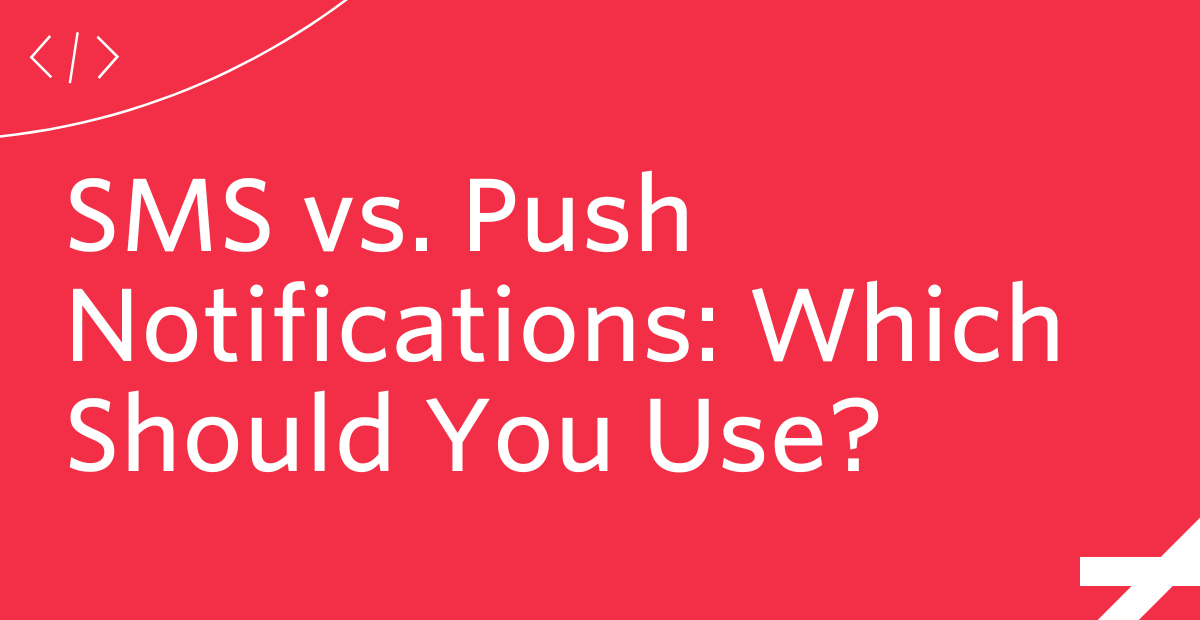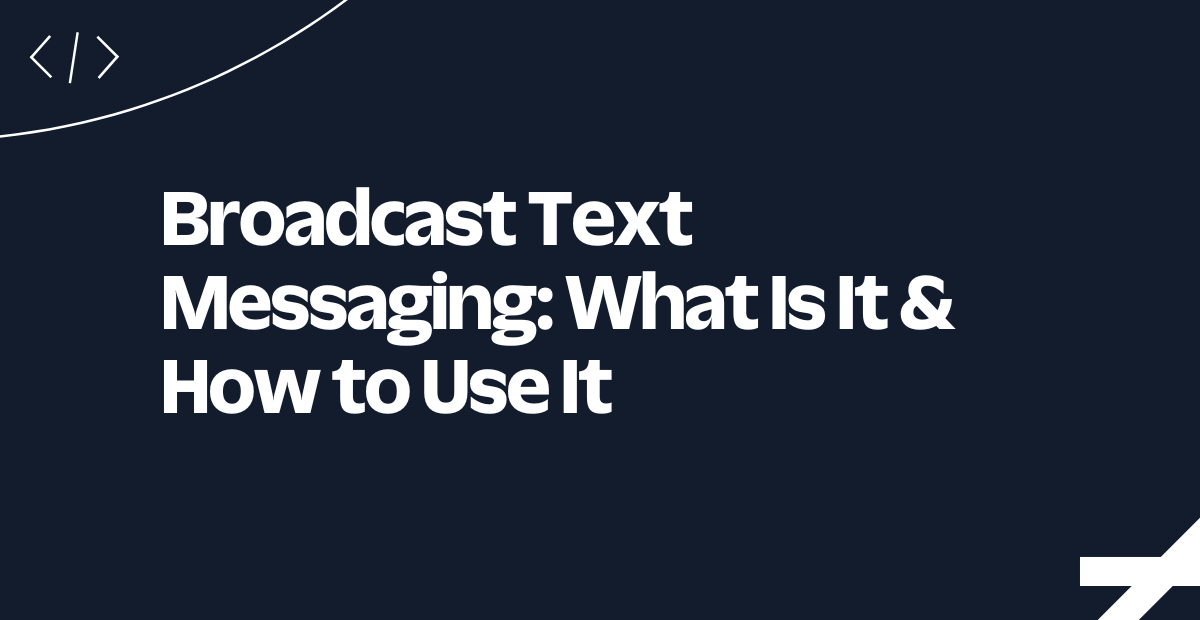Buy vs. Build: 4 Things to consider for user verification
Time to read:
Buy vs. Build: 4 Things to consider for user verification
Organizations must choose between building an in-house user verification solution or buying an out-of-the-box solution in today's ever-changing user verification landscape. This dilemma comes from the tremendous transformation seen in the field of user verification. According to the trade body MEF, 89 percent of consumers now regularly receive texts from brands, with user verification being one of the main use cases. From SMS authentication to Push authentication, each method has tradeoffs for building vs buying. Obstacles such as resource allocation, infrastructure scalability, delivery performance, the dynamic nature of fraud, and user preferences make the decision hard. The industry issue is technological improvements, changing consumer expectations, and user verification implementation complexity.
Our blog post aims to guide businesses in deciding whether to build or acquire a user verification solution by exploring the pros and cons of each option. Make an informed decision via an in-depth examination of the elements driving this decision.
1. Scale as you grow
Intuit, a global financial technology platform, wanted to build an in-house global SMS verification flow while growing rapidly. Initially focusing on short codes within the US, they aimed to expand to 200+ countries. However, the complexity of obtaining short codes for each country led to significant delays, taking up to nine months per country due to regulatory hurdles.
Intuit tried a new angle to accelerate their expansion and enhance customer authentication security. They prioritized time to market, emphasizing the need for a solution supporting global expansion while ensuring a secure authentication experience for their users. Intuit selected Twilio Verify in order to scale over 200 countries and provide the time-to-market and scale they were looking for.
As Shikha Tikku, Principal Product Manager, from Intuit said “There had to be a better way to go live in 200+ countries in much less time with fewer resources!”
As businesses achieve increasing success or change their priorities, it becomes crucial for them to contemplate how these changes will affect their operations. While growth is undoubtedly positive and change can bring different benefits, it also comes with a set of challenges that if not addressed properly could potentially lead to delays, disruptions or missed goals.
Related to user verification, challenges that need to be addressed when building your own user verification solution are:
- Route optimization: The capability to choose the best route to deliver critical one-time passcodes and avoid network failures and downtime. Failing to do so can translate into a reduction in conversion rates, because of delivery delays and retries which will also mean increased costs, loss of trust and revenue.
- System updates and platform innovations: Updating your system for other purposes may impact your verification flow or any innovation may create additional challenges that could interrupt your verification process from working properly which could increase support costs and a drop in conversion rates.
- Multichannel capabilities: New communication channels are coming up as new ways to verify users around the world. Having a multichannel approach can help to increase conversion by keeping user preferences in mind. Not including other methods of communication can leave a group of customers out of reach for your business.
- High volume traffic events: Sudden increases in volume traffic during peak events that need to be managed (e.g. Black Friday, Cyber Monday, New product/features releases, among others). These events are often related to lots of additional revenue potential opportunities and not being prepared can reduce the effectiveness to capture these opportunities
- Variety of languages and translations: Translations are key to communicate and reduce friction with your users. If not considered, conversion can experience drops from the lack of understanding from the users and an increase in support costs.
Investing in an out-of-the-box verification solution can expedite this growth by eliminating the intricacies associated with scaling.
2. Total cost of ownership (TCO)
Stripe was looking to include SMS verification for their two-factor authentication flow. They wanted to scale with ease and not have to deal with what building an SMS verification flow involved. They were looking for a verification process where the message, code or link got where it needed to be. Performance and cost were a key piece within their evaluation and why they chose to buy from a third party vendor so users could be verified easily while avoiding support costs helping them provide a more streamlined experience.
“If a message is not delivered, we get a phone call and have to get our support people on it,” he said. “Verify greatly reduces our own support costs over other verification methods.”
As Suhas Joshi from Stripe highlighted “It’s a no brainer to use Twilio,” he said. “We never even considered building something in house because there’s so much involved in it and we’re just happy to be able to rely on Twilio to take care of it so we can focus on making the experience for our users simpler and easier”.
The total cost of ownership (TCO) is a main factor to analyze when developing your own verification solution. When calculating the TCO, organizations need to figure in the cost of building the application plus the time of delivering it in addition to the cost of operating it. Broken down, you might use the following items to figure out the total TCO:
- Multi sourcing reduction: using different vendors as a back-up plan or as an alternative option for SMS verification can heavily increase the cost plus the time that requires the implementation of each one of the options. Delivery reliability may not be the same across vendors or solutions that might also increase cost and reduce conversion rates.
- Managing phone numbers: Acquiring phone numbers and maintaining them to efficiently deliver SMS verification. Implementing phone numbers such as short codes can be time consuming and might delay the deployment of your user verification solution.
- Developer resources: Salaries and people time invested building a user verification solution that could be invested in other priorities.
Deploying a verification solution can be costly and can impact verification and growth targets. It requires expertise building and implementing across the business. If know-how and people and economic resources and expertise are lacking, purchasing from a third-party vendor can be a wise choice.
Opting for an out-of-the-box verification solution can save time and allow businesses to focus on their core activities, intensifying their pursuit of goals. This approach can reduce the total cost of ownership by outsourcing development, relying on the solution of choice to manage the ongoing maintenance, and other hidden costs such as time to deploy, know-how, challenges to solve while building, support costs, and more.
3. Out-of-the-box features
Colinet explained that before integrating Twilio Verify, Paack did not have a digitally traceable way to provide end-to-end delivery verification in a way that allows for flexibility while maintaining security. Twilio Verify enables proof of delivery (PoD), which streamlines the customer experience with convenient delivery notifications via text, as well as reduces the risk of non-delivery.
“These kinds of capabilities were not even thinkable before,” he added. “Twilio gives us a single umbrella from which to expand from one country to another.” Colinet said from Paack.
The user verification industry is constantly changing, and in response, a verification solution must stay current. To do that, solutions must have new features and capabilities that can effectively combat fraud while simultaneously improving the user experience and verifying users are who they say they are. Some essential features organizations might look for include:
- Fraud protection features: New fraud schemes such as SMS Pumping fraud can impact your engineering team’s time, tools and increase significantly user verification costs before you can realize you are being attacked.
- Failover network: Avoid relying on multisourcing when you can count on a user verification solution that has its own backup network if there is ever a problem. This can ensure delivery at a critical time for the user.
- Managing phone numbers: Avoid worrying about acquiring phone numbers and benefit from a pool of phone numbers that will let you deploy your OTPs immediately.
- Pre approved carrier templates: a variety of message body options available for immediate use. These can avoid getting your OTPs blocked by carriers and having users unsatisfied with their experience.
- Dashboard for reporting and monitoring: Verifications attempted, converted, verification expenses, regional breakdown, and more. These metrics can help you keep track of your performance and, additionally, keep costs down.
Buying from a third party vendor can provide all these benefits immediately while handling fraud and will keep including new capabilities that will only strengthen your verification flow.
4. Regulation and compliance
As Shikha Tikku, Principal Product Manager, from Intuit said “One of the challenges in the space is understanding the local laws and regulations, and then keeping up with them.”
Staying current with regulations is imperative for user verification solutions. This involves adhering to ever-evolving rules and laws, including but not limited to:
- TCPA
- Schrems II
- A2P 10DLC
- Sender ID requirements
Companies must assess whether they possess the resources and expertise necessary to comprehend how these regulations influence their operations.
Implementing regional data processing instances and dynamic linking for multi-factor authentication are just a couple of the essential strategies for ensuring regulatory compliance. Furthermore, obtaining short codes often entails navigating through regulatory obstacles before implementing them to ensure that businesses are being compliant with their use.
Buying an out-of-the-box solution can solve this by offering a product that is already compliant and stays on top of evolving legislation.
Still undecided? Let us help
There are many reasons why buying a pre-built solution can be a good option when adding a verification solution to the customer journey. Buying will, in most cases, offer greater efficiency, lower cost of custom development, allow customization with custom code, and takes the burden of staying on top of shifting regulations off of the users.
Twilio: Your trusted partner for user verification
Our proven expertise and comprehensive Verify API is already being used by customers around the world.
Related Posts
Related Resources
Twilio Docs
From APIs to SDKs to sample apps
API reference documentation, SDKs, helper libraries, quickstarts, and tutorials for your language and platform.
Resource Center
The latest ebooks, industry reports, and webinars
Learn from customer engagement experts to improve your own communication.
Ahoy
Twilio's developer community hub
Best practices, code samples, and inspiration to build communications and digital engagement experiences.


